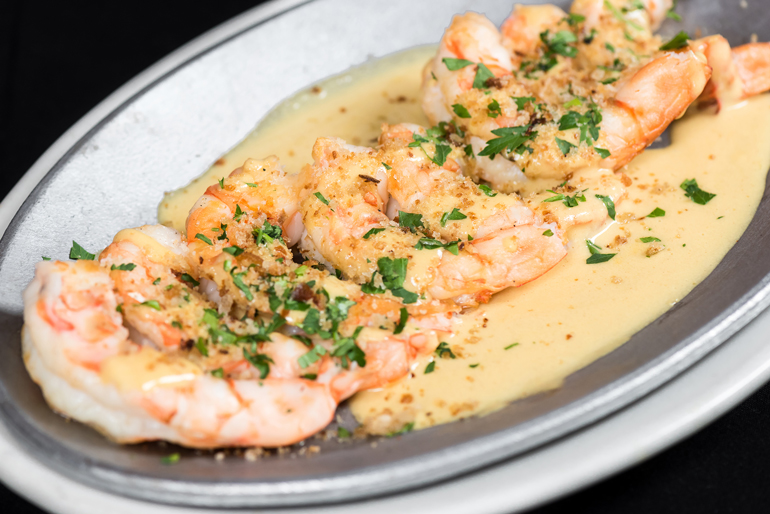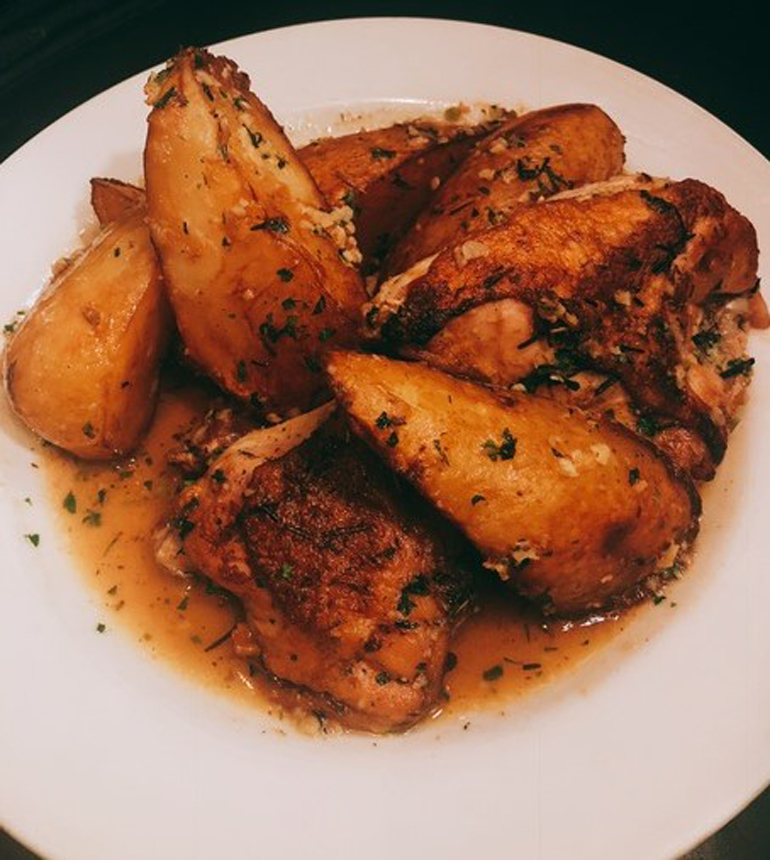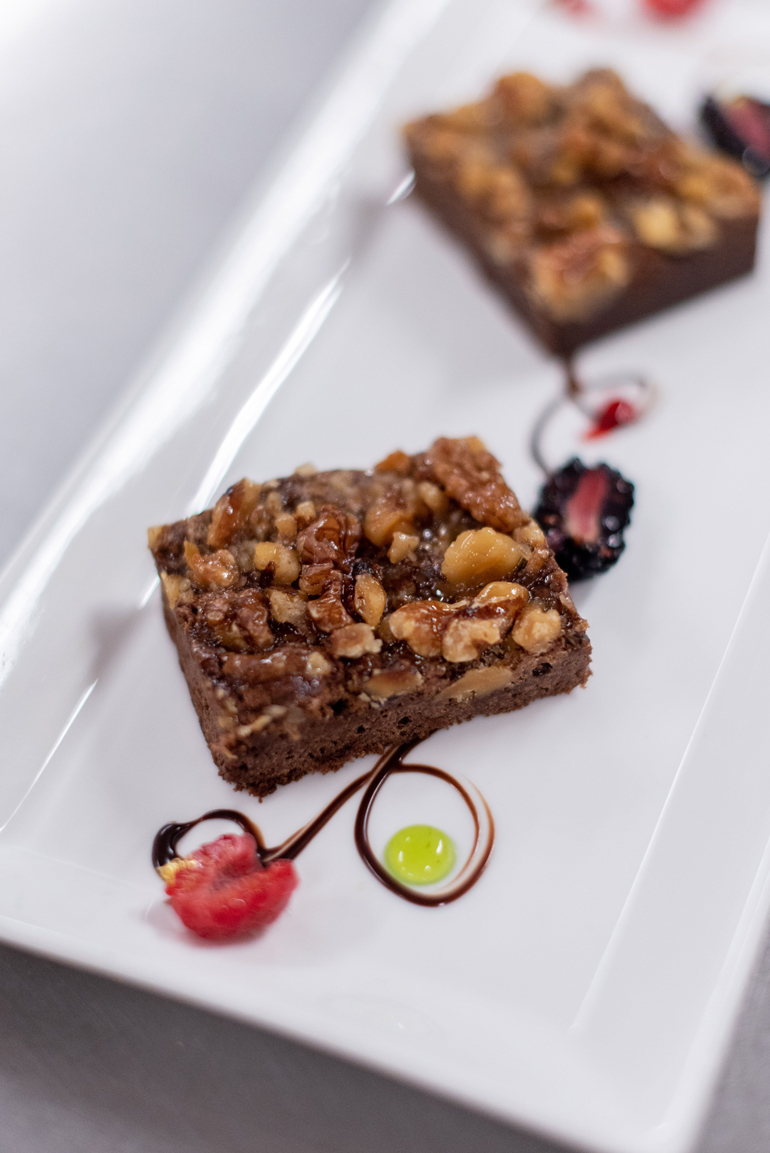Most Chicagoans are very familiar with the nationally recognized triumvirate of Chicago original foods: deep-dish pizza, the Chicago hot dog, and Italian beef. When friends and family come to visit, you can be sure that it’s going to be one (and sometimes all) of these big three Chicago original foods that they’re going to want to eat.
The culinary inventiveness of Chicagoans, however, goes far beyond these undeniably delicious and popular, though humble, creations. Chicago is also home to several fine dining creations — like Shrimp DeJonghe and Chicken Vesuvio — as well as what is now one of the most popular baked treats anywhere: the Brownie.
Shrimp DeJonghe, Chicken Vesuvio and the Brownie were all born in Chicago. Here are the stories of those other big three Chicago original foods and where, today, you can enjoy them.
Shrimp DeJonghe

Brothers Charles and Pierre DeJonghe came to the United States from Belgium in 1893 to serve food at the Columbian Exposition. This massive fair was to prove a high-visibility venue for the introduction of many innovative foods, including Hershey bars and the all-American hamburger.
After their success at the Exposition, the brothers in 1899 went on to open the DeJonghe Hotel and Restaurant (12 E. Monroe). In those relatively early days of Chicago dining, just a few decades after the Great Fire, standalone restaurants were not yet a “thing,” and hotels were frequently where people went to dine out.
According to former Tribune editor Carol Mighton Haddix, DeJonghe’s restaurant in its early years “drew the elite … But in 1923, the brothers ran up against the dry liquor laws of the day, and the hotel was closed down by the feds, never to reopen.”
Shrimp DeJonghe, first served at DeJonghe’s Hotel and Restaurant, lives on to this day at several Chicago restaurants. The dish is stunningly simple: shrimp, breadcrumbs, garlic, sherry or wine, butter and maybe cream, lemon juice, salt, and some spices like tarragon and marjoram. Different restaurants prepare it differently, and the essential ingredients seem to be the shrimp, breadcrumbs, and garlic; after that, chefs modify this casserole at will.
At Hugo’s Frog Bar and Fish House (1024 N. Rush), Chef Russell Kook does a version of Shrimp DeJonghe that follows a mostly traditional approach, “but we add Dijon mustard,” says Kook, “to provide a little acidity. And you need the acidity from the mustard, wine, and lemon juice to balance the richness of the butter and the cream. The mustard also adds a savory note to the dish that our customers really like.”
For the wine, says Kook, “We use a pinot gris because we want the wine flavor to be in the background, not the foreground.”
Shrimp DeJonghe is the right dish to serve at Hugo’s Frog Bar and Fish House, says Kook, “because we want to serve food that fits the surroundings. We have an old school space, and we want our food to reflect the atmosphere.”
Shrimp DeJonghe, Kook tells us, is a “big favorite with customers, who appreciate the tradition, and when they’re eating Shrimp DeJonghe, they’re eating Chicago history.”
Chicken Vesuvio

Though it seems likely that a preparation of roasted potatoes and chicken might have been served (in say, Greece or Italy) for probably centuries before it appeared on the menu at Chicago’s Vesuvio Restaurant (15 E. Wacker) in the 1930s, this dish is now indelibly associated with the now defunct restaurant of the same name.
In Chicago, Chicken Vesuvio is still proudly served at many local restaurants, usually those that have an Italian heritage or theme, including Harry Caray’s Italian Steakhouse (33 W. Kinzie), Gene & Georgetti (500 N. Franklin), and, of course, Italian Village (71 W. Monroe), all a short walk from the site of the original Vesuvio Restaurant. At all those places, what you get when you order Chicken Vesuvio is roasted chicken and potato wedges, sometimes with peas, but almost never with the kind of chili heat the name “Vesuvio” might suggest.
At Italian Village, Chicago’s oldest Italian dining establishment, Chef Jose Torres follows a relatively traditional recipe, including cut-up chicken, olive oil, garlic, white wine, salt, pepper, garlic, oregano, and canola oil, for frying. The quick pan-frying of the chicken is a critical step, says Torres, adding “you want to get the oil hot before you put the chicken in, skin-side down, then you flip it over to the bone side to get a nice crispiness all around.”
“This is how we’ve done it for years,” says Torres. “It’s tradition. It brings in a lot of flavor to sauté the chicken with herbs, and it looks more appetizing and appealing. When you stack it up, it looks more like a volcano, Mount Vesuvius!”
The potatoes can be browned in the same pan as the chicken, and then everything is baked together, except the peas, which (if you’re using them) go on at the end.
It’s important to cook the chicken on the bone because, as Torres says, “the bone keeps it juicy and moist,” though it can be prepared “without the bone, for people who don’t want to mess with the bone, or skinless, for those who don’t want the fat or calories in the skin.”
Chicken Vesuvio has influenced several spin-off dishes, including Vesuvio Pork Chops and Vesuvio Steak, reflecting many of the same ingredients of the original Chicken Vesuvio. And even with the dish itself, there’s room for individual variation; for instance, says Torres, “we don’t use the peas in our Chicken Vesuvio because we’ve never done it with peas.”
Tradition is powerful.
The Brownie

The brownie is so generally known that unlike Shrimp DeJonghe and Chicken Vesuvio, the name “brownie” is usually not capitalized. The brownie seems eternal, like it maybe didn’t even have a home, like it just … happened.
But no, the date of the brownie’s inception and the first place it was served are all a matter of historical record.
According to Ken Price, Palmer House Director of Public Relations/Historian, the first brownie was served at the Columbian Exposition of 1893, at the direction of Bertha Palmer of Chicago’s Palmer House. “Bertha was made President of the Board of Lady Managers at the fair,” says Price, “which was a very important part of the city of Chicago’s history.”
The illustrious Mrs. Palmer directed Joseph Sehl, Palmer House chef, to prepare a unique treat that could be included in the boxed lunches available in the Women’s Pavilion at the fair. “She wanted something more than just a piece of cake or pie or a clump of fruit,” Price explains. “She told her chef she wanted something like a cookie but denser than a cookie. And it had to be chocolate. Bertha loved chocolate.”
The brownie was subsequently served at the Palmer House restaurant and, before too long, everywhere.
The brownie is still served at Potter’s and Lockwood, two restaurants in the Palmer House, and it’s a little different than today’s standard-issue brownies in that it contains, in accord with the original recipe, apricot preserves, and it’s very gooey and chocolate-y, almost like candy.
“Our brownies have a very high level of cocoa butter,” says Price, “so it’s a little like fudge, and part of that is because the ingredients have to sit and chill for an hour and a half after they’re all mixed together. A lot of people think it’s fudge, but it’s not, because it’s baked, and fudge is not baked. The Palmer House brownie is very dense.”
Sitting in Potter’s in the Palmer House, right across the street from where the old DeJonghe restaurant once stood, you might try to imagine what it would have been like to bite into one of these desserts before it was even called a “brownie.” It’s probably fair to say that in the late nineteenth century, minds would have been blown. Today, the brownie is an everyday item, available at coffee shops around the country, but back then, it would have been something new and perhaps as startling as the other inventions — like the Ferris wheel, zipper, and Cracker Jacks — also unveiled to the world for the very first time in 1893 at The White City.
 David Hammond is Dining and Drinking Editor at Newcity and contributes to the Chicago Tribune and other publications. In 2004, he co-founded LTHForum.com, the 15,000 member food chat site; for several years he wrote weekly “Food Detective” columns in the Chicago Sun-Times; he writes weekly food columns for Wednesday Journal. He has written extensively about the culinary traditions of Mexico and Southeast Asia and contributed several chapters to “Street Food Around the World.”
David Hammond is Dining and Drinking Editor at Newcity and contributes to the Chicago Tribune and other publications. In 2004, he co-founded LTHForum.com, the 15,000 member food chat site; for several years he wrote weekly “Food Detective” columns in the Chicago Sun-Times; he writes weekly food columns for Wednesday Journal. He has written extensively about the culinary traditions of Mexico and Southeast Asia and contributed several chapters to “Street Food Around the World.”
David is a supporter of S.A.C.R.E.D., Saving Agave for Culture, Recreation, Education and Development, an organization founded by Chicagoan Lou Bank and dedicated to increasing awareness of agave distillates and ensuring that the benefits of that awareness flow to the villages of Oaxaca, Mexico. Currently, S.A.C.R.E.D is funding the development of agave farms, a library and water preservation systems for the community of Santa Catarina Minas, Oaxaca.
